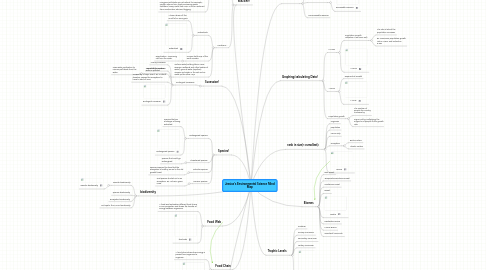
1. Food Chain
1.1. A food chain shows how energy is passed from organism to organism.
1.2. food chain
2. Food Web
2.1. A food wed embodies different food chains in one ecosystem and shows the transfer of energy between organisms.
2.2. food web
3. biodiversity
3.1. Genetic biodiversity
3.1.1. Genetic biodiversity
3.2. Species biodiversity
3.3. Ecosystem biodiversity
3.4. Hot Spots- the MOST biodiversity
4. Species!
4.1. Endangered Species
4.1.1. Species that are endanger of being extincted.
4.1.2. Endangered species
4.2. Threatened Species
4.2.1. Species that could go endangered.
4.3. Indicator species
4.3.1. Species required to show that the ecosystem is healthy. Ex owl in the old growth forest.
4.4. Pioneer Species
4.4.1. First species to start out in an ecosystem. Ex. Lichens, grass, moss.
5. Sucession!
5.1. Ecological Sucession
5.1.1. Primay Sucession
5.1.2. Secondary Sucesssion
5.1.3. Caused by a major event. Ex. a natural disaster! Causes the ecosystem to have to start all over.
5.1.4. Ecological sucession
6. Ecosystems...
6.1. A climax community is the most species the ecosystem can support
6.2. All ecosystems have limiting factors... to keep the population from reaching carrying capacity
6.3. Carrying capacity is the the maximum number or organisms in a species that the ecosystem can support if it reaches carrying capacity the ecosystem will begin to die from lack of resources!
6.3.1. Example! easter Island!
6.4. Ecosystem
7. WATER!!!
7.1. Water Pollution
7.1.1. Causes: Runoff, ersion, urbanization
7.1.1.1. Impermiable surfaces cause stormwater runoff to travel into grasses or water ways
7.1.1.1.1. Impermiable-not allowing water through it
7.1.1.2. Urbanization
7.1.2. Point source is when you can locate the source of the pollution
7.1.3. nonpoint source is when the source is untraceable and you can not locate the source
7.1.4. organic pollutants are natural ones such as food processing waste, brush and debre from logging, detergens, or insecticides and herbicides.
7.1.5. inorganic pollutants are not natural. for example; acidity, amonia from food processing waste, fertilizers, heavy metal from cars, or silt or sediment from construction sites and logging.
7.2. Locations...
7.2.1. Watersheds
7.2.1.1. A basin where all the runoff of an area goes
7.2.1.2. watershed
7.2.2. Oceans hold 87% of the Earth's water!
7.2.2.1. Desalination - Removing salt from the water
7.2.3. Surface water(inclding lakes, rivers, swamps, wetlands and other bodies of water), ground water (aquifers), icecaps and water in the soil and air make up the other 13%
7.2.3.1. 40% of all the surface water is poluted
7.2.3.1.1. Uses water purification to remove pollutants from the water
8. Biomes
8.1. Rain Forest
8.2. Temperate Deciduous Forest
8.3. Coniferous Forest
8.4. Desert
8.5. Tundra
8.6. Freshwater Biome
8.7. Marine Biome
8.8. Grassland/ Savannah
9. Trophic Levels
9.1. Producer
9.2. Primary Consumer
9.3. Secondary Consumer
9.4. Tertiary Consumer
9.5. Decomposers
10. rank in size(1=smallest):
10.1. Organism
10.2. population
10.3. community
10.4. ecosystem
10.4.1. Biotic Factors
10.4.2. Abiotic Factors
10.5. Biome
11. Graphing/calculating Data!
11.1. S curve
11.1.1. Population Growth rate(when it will even out)
11.1.1.1. The rate at which the population increases
11.1.1.2. Ex. Romania's population growth rate is -0.007 and Polands is 0.000
11.1.2. S curve
11.2. J curve
11.2.1. Exponential Growth
11.2.2. J curve
11.3. Population growth
11.3.1. The number of people the country increases by.
11.3.2. Figure out by multiplying the original # of people to the growth rate.
12. Resources
12.1. Natural resource
12.2. Renewable resource
12.2.1. Renewable resource
